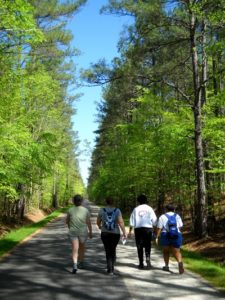I love a good trail, and while I’m familiar with a lot of traditional hiking trails in North Carolina (see “Backpacking North Carolina” and “100 Classic Hikes in North Carolina”) I’m less familiar with the state’s rails-to-trail’s projects. I realized this in December when, on a 50-mile backpack trip of the North Carolina Bartram Trail, I suddenly found myself on a 1.2-mile stretch of paved greenway along the Nantahala River. Later, I learned that I’d been on the Nantahala Bikeway, a U.S. Forest Service project that incorporates a half mile of old railbed along the Nantahala River in Swain County (near Patton’s Run, for you whitewater boaters).
I learned this by noodling around on the North Carolina Rail-Trails Web site, where I discovered the Nantahala Bikeway is not alone. In fact, there are 30 rails-to-trails projects in North Carolina encompassing 130 miles of trail. You’ve probably heard of one or two. In the Triangle, for instance, nearly everyone knows the American Tobacco Trail, a 22-mile, nearly complete trail that runs from western Wake County into downtown Durham. In the mountains, there’s the popular Thermal Belt Rail-Trail, which runs 8 miles from Spindale to Gilkey in Rutherford County, and the 4.5-mile Little Tennessee River Greenway in Macon County. At the coast, folks may have spent some time on the 5.5-mile Jacksonville-Camp LeJeune Rail-to-Trails in Onslow County.
What hampers the visibility of rails-to-trails projects in North Carolina is the absence of true superstars: Virginia’s 57-mile New River Trail and the 34-mile Virginia Creeper Trail; the 184.5-mile Chesapeake & Ohio Canal National Historic Park trail in D.C. and Maryland; or the granddaddy, the 237-mile Katy Trail, which spans most of Missouri. We have no superstars in large part because, unlike in the north and Midwest where railroad companies have been willing to abandon long stretches of line, the obvious prerequisite for a rails-to-trail conversion, rail companies here retain hope that even their abandoned lines may once again become economically viable. And so, we have 30 projects across the state that have capitalized on smaller abandonments, from the 22-mile American Tobacco Trail to the half-mile Lansing Trail in Ashe County.
Tag Archives: Rails-to-Trails
East Coast Greenway Alliance moves in to help N.C. move on
When the East Coast Greenway Alliance announced in February it was moving its headquarters from Rhode Island to the Triangle, the move was a good sign for the state — and a sign that we need help.
The Alliance is the driving force behind the East Coast Greenway, an in-the-works greenway that will one day run continuously from Key West, Fla., to Canada, a distance of nearly 3,000 miles. It bills itself as the urban alternative to the Appalachian Trail, offering a pedestrian-width ribbon of pavement instead natural surface and traveling through as many municipalities as possible, rather than avoiding them. More than 25 percent of the trail now exists. Problem is, the vast majority of the completed path lies well to the north.
New River Trail: 57 miles of bike trail less than 3 hours away
The physical therapist hesitated, then issued his edict. “Maybe. If it’s a short hike. And if the trail doesn’t have a lot of rocks.” He hesitated again, “I dunno … .”
“What a bike ride?” I asked.
It was Marcy’s first meeting with a PT to deal with a nagging case of planter fasciitis. She’d been hobbled off and on by the annoying muscle irritation; her most recent flair-up courtesy of a walk-to-run program. We were at Cary Orthopaedic’s Performance Therapy unit — because past experience revealed they were just as interested as we were in getting us moving again as soon as possible. PT Kevin Raymond was on board with that, he just wanted to make sure Marcy didn’t go out too fast.
